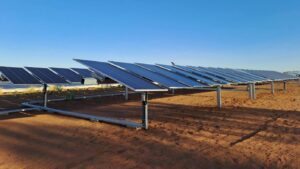PRESS RELEASE
SYDNEY, Nov 16 – A re-elected Labor government would deliver the steepest reduction in Victorian wholesale electricity prices, while the Greens would oversee the sharpest reduction in carbon pollution, according to a new report by energy market analyst RepuTex.
The report, commissioned by Greenpeace Australia Pacific, modelled the impact of the energy policies of the ALP, the Coalition and the Greens to 2025 and found that the Coalition’s energy plans will result in both highest wholesale power prices and emissions of the three major parties, with the ALP performing best on prices and the Greens on emissions reductions.
“This report provides further confirmation that an electricity system driven by coal is the worst of all worlds, driving up power prices and carbon pollution,” Greenpeace Australia Pacific Head of Research and Investigations, Dr Nikola Casule, said.
“Renewable energy technologies are already driving down soaring power prices and drastically reducing carbon pollution. We need more renewable energy to accelerate this trend for the benefit of all Victorians and the environment.”
Under all three party scenarios, emissions are projected to fall sharply by 2020 from their 2018 highs, driven by new renewables coming online as a result of Labor’s Victorian Renewable Energy Target (VRET) and increasing rooftop solar uptake.
“The VRET is already putting downward pressure on prices and that trend will gain momentum as more wind and solar projects are rolled out across Victoria,” Dr Casule said.
When it comes to emissions, the Greens policy of 100 per cent renewable energy by 2030 would deliver the steepest cuts, with total emissions from the electricity sector projected to fall from 41 Mt per annum (Mtpa) in 2018 to 26 Mtpa in 2025, a drop of 37 per cent.
Under the Greens policies wholesale power prices would fall by 14 per cent from $98 per MWh in 2018 to $84 in 2025. Labor’s support for LNG and the Coalition’s support for fracking were outside of the scope of the report because they are not related to domestic electricity.
“The Greens are head and shoulders above the other parties when it comes to emissions reductions, and their policies are the only ones that are in any meaningful sense correlated to the scale of the climate crisis.”
Labor’s policies lead to the greatest saving on prices: a 31 per cent fall by 2025, from $98 per MWh to $68 per MWh. But their impact on emissions is a far more modest 5 per cent reduction within the Victorian electricity generation sector – despite renewables reaching 48 per cent of Victorian-based generation by 2025. This is due to the closure of NSW’s Liddell coal fired power station, the shortfall from which will largely be imported from Victoria, handing a lifeline to the state’s ageing brown coal plants.
The Coalition’s plan to scrap the VRET would lead to a sharp increase in emissions and the lowest price benefit to electricity customers. Emissions will rise by 5 per cent to 2025 while wholesale power prices are projected to dip from $98 per MWh in 2018 to $87 by 2025, an 11 per cent reduction mainly driven by projects already delivered under the VRET. But scrapping that scheme will put a brake on investment in renewables and the additional price benefits that it would bring.
“The RepuTex analysis clearly demonstrates that a vote for the Coalition is a vote not only for more carbon pollution, but also for higher costs when compared to the other major parties,” Dr Casule said.
“Victoria is already enjoying the benefits of clean wind and solar projects. Existing policies should be strengthened and clarified, not scrapped. The fact that the Guy opposition is even suggesting scrapping the government’s popular policies suggests that vested interests in the fossil fuel industry are dictating the Coalition’s energy policy. It’s clear that Victorian energy customers and the environment will be the losers.”










